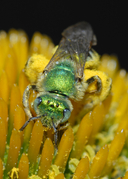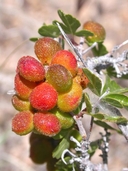| |||||
|
Updated November 23, 2022
This application shows additional characteristics of a plant,
including
what other organisms are associated with the plant,
and factors that affect where the plant is likely to grow.
| |||||
| ASSOCIATIONS | |||||
|
This application shows information about known associations between a plant and other organisms, including
|

The butterfly icon appears for plants known to be attractive to benefical insects. | ||||
|
This data has been compiled from many sources. Data about bees and other beneficial insects are from the Xerces Society. For purposes of this application, Xerces indicated which California plants are favored by native bees, bumble bees, honey bees, and predatory or parasitoid (beneficial) insects. Xerces also indicated which plants native bees are likely to use for nesting material. More information about beneficial insects is available here:
Data about butterflies is from Data on sharpshooters and Pierce's Disease is from
Data on Sudden Oak Death is from the
For more information on pests and pathogens associated with particular plants, please see Calinvasives. |

Metallic green sweat bee © 2007 Gary McDonald |
||||
| PLANT TOLERANCES (GROWTH CHARACTERISTICS) | |||||
|
Climate Characteristics
(or something close to that). These numbers were obtained by examining all high quality georeferenced records of this plant in California, deriving the annual precipitation for each location from the PRISM data, and then saving the high and low end of this range. |
Annual Precipitation
(min / max)
Wet Season (number of months: min / max) Temperature Range (min / max) Growing Season (number of months: min / max) Accumulated Temperature (min / max) USDA Hardiness Zone (min / max)
|
||||
|
Soil Characteristics
|
|
||||
|
Derivation
|

|
||||
|
USDA PLANTS Conservation Plant Characteristics
|
|||||
| PLANT LOCATION SUITABILITY | |||||
|
Plant Location Suitability
is a separate application which compares the
actual climate and soil characteristics of a location
with the tolerances
of a particular plant.
There is a link to this application from the
Taxon Report page and the Plant Characteristics page.
| |||||
| EXAMPLES | |||||
|
Rhus aromatica, Fragrant sumac Solidago spathulata, Dune goldenrod Ribes sanguineum, pink flowering currant Rubus armeniacus, Himalyan blackberry
|

Rhus aromatica © 2005 James Andre | ||||
| RELEASE NOTES | |||||
|
2022 November Version 0.88 works on mobile devices. 2021 June Version 0.87. 2016 November In version 0.75, the various factors are shown in both American units (inches, feet, degrees Fahrenheit) and metric units (meters, centimeters, degrees Centigrade). | |||||
